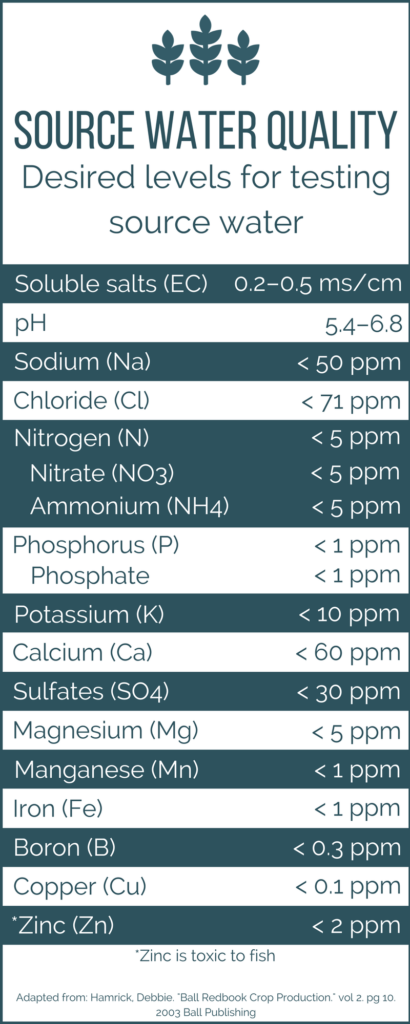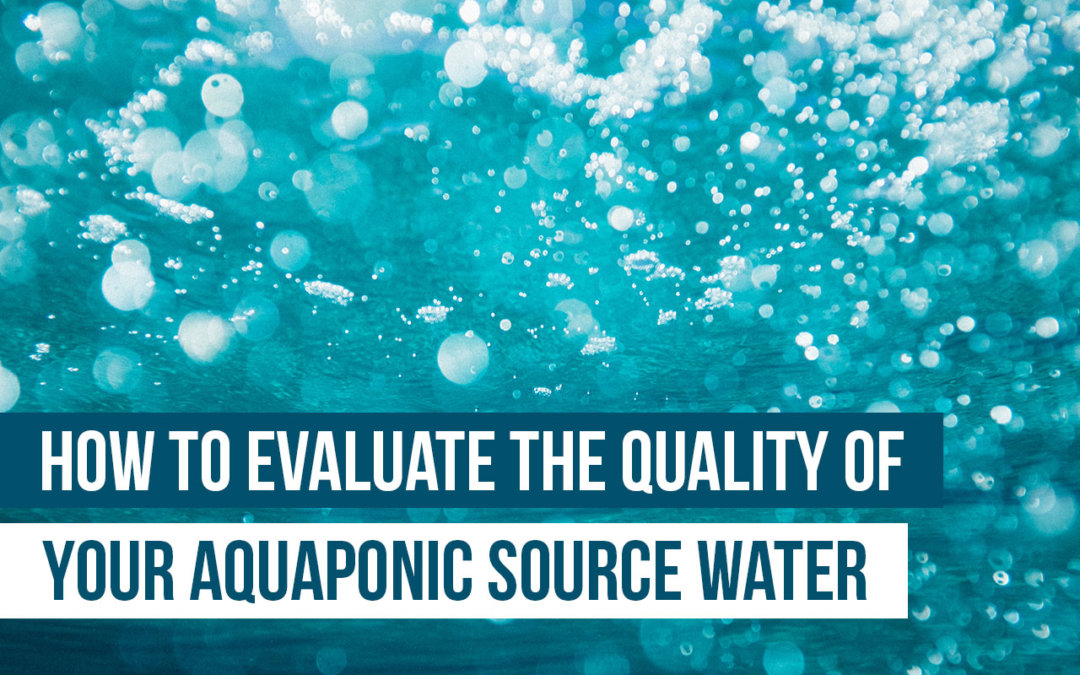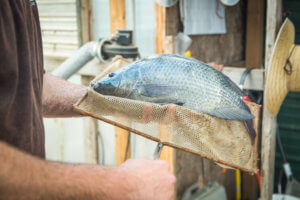Water is a necessary input for all plant life. Soil-based agriculture uses irrigation water from rain, lakes, rivers, reservoirs, and aquifers. But what about sourcing hydroponic and aquaponic water?
Growing hydroponically or aquaponically means that you depend heavily on water; and the quality of that water is paramount. Water is the largest and most important component of these systems and the way nutrients are brought to plants. That water has to come from somewhere.
The raw input of water is known as source water. But not all water is equal; water can have different levels of oxygen, can be treated, or can be contaminated. It’s important to pay close attention to the quality of the water you put into your system, especially if yours is aquaponic and will be used to accommodate fish.
In 1974, the Safe Drinking Water Act was put into effect and the Environmental Protection Agency mandated that all drinking water be treated to reduce the potential for bacterial contamination, among other hazards¹. While the water is safe for human consumption, aquaponic systems rely on bacterial and microbial life. The removal of this microbial life can seriously limit plant growth (meaning that plants and fish can die in treated water).
The water you add to your system can have a dramatically different starting point depending on:
-
- Where you live
- Whether you’re pulling from municipal or well sources
- The recent weather.
- The year—municipal water treatments can change over time without you knowing.
It’s super important to have at least a basic understanding of your water parameters, especially if you notice them change over time (which you likely will). When raising fish, you need to understand what you’re putting into their living environment so you don’t inadvertently kill them. The same goes for plants, which require specific conditions in order to efficiently take up nutrients.
Main things to consider when sourcing aquaponic water
Just as every system is unique, so are the environmental and water conditions of each location. “The treatment of groundwater varies from community to community, and even from well to well within a city depending on contaminants in the water².” Communities treat water so that it is consumable for humans, and this process often involves adding chemicals and minerals to reduce the risk of contamination.
In addition to noting the chemicals, you will need to account for all of the existing nutrients in the water before adding any supplements or adjusting pH or EC measurements.
Chlorines and chloramines
Chlorine and/or chloramines are added to almost all municipal water sources as a sterilizing agent. Chloramines are formed in water when chlorine is added in combination with ammonia. Both chlorine and chloramine are fatal for your nitrifying bacteria that are the foundation of your aquaponic system.
Treat the water with a food safe dechlorinator prior to adding water to your system. If there is no food safe dechlorinator available, leave the water out in an uncovered container for at least 24 hours (preferably with an active aerator), and the chlorine will bubble off.
Unfortunately, chloramine does not dissipate the way chlorine does. If your source water has been treated with chloramine as a disinfectant, use a carbon filter to remove the chlorine compounds.
Be sure to test the water before adding it to your system.
pH
pH, or the acidity of the water, can change drastically based on municipal water treatment and recent weather. If it’s rained in the past 24 hours, you are likely to see a change in your normal pH. Treated municipal tap water can range from 6–8 or even higher. pH affects the availability of the nutrients in your system, so you will likely need to adjust it according to your plants’ needs.
Hardness

The hardness of your source water is important because it affects the buffering capacity of your system. Hardness is a measure of the levels of dissolved calcium and magnesium in the water. The harder the water, the more dissolved minerals are in it.
Well water is typically very hard due to the abundance of natural minerals and carbonates. Tap water tends to have a lower hardness, and will, therefore, lend itself to a system that is more susceptible to pH swings. Do not use water if it has been softened. Softened water has been treated with salts that you do not want in your system.
Temperature
Avoid adding water that is very different in temperature to that already in your system. When starting your system, make sure that the water is not too hot or too cold—you could seriously shock your plants and increase your seedling loss rate.
The best way to know the quality of your source water is to send a test sample to a lab. Most universities and some state agricultural departments can perform the assessment for you, but you must get the sample to them within 2 days. When you get your test back, compare it to this chart, and use it to guide your water treatments. Make sure you take your plants’ needs into account as well, as nutrient, pH, and EC levels differ across crop types.
Overall tips and tricks:
The most important thing to remember about adjusting water parameters is incremental change. Make small changes, slowly. You can always add more or make changes later, but doing too much could cause an undesirable and irreversible alteration of your system conditions.
- Perform all adjustments and additions to water outside of the system. This will prevent any unintended swings in conditions, which are harmful to all 3 of the living organisms: fish, plants, and bacteria. This is especially important if your tank has low hardness and is therefore susceptible to quick changes.
- Never add or remove more than ⅓ the total volume of your system at one time. If you need to top off with more than ⅓ of the total in one day, do one addition in the morning and another at night.
- It’s best to add water to the grow bed area rather than directly into the fish tank. This will lower the chances of fatal swings and mistakes that would create a dire situation for your fish.
- If you’re going to adjust only 2 things before adding water to your system, it should be pH and dechlorination. Maintain pH between 6 for mature aquaponic systems and low 7s for young systems. Big picture, a lower pH within the 6–7 range will lead to healthier plant growth. Removing chlorine and chloramines from your source water is a non-optional step in maintaining a healthy aquaponic system.
Conclusion
Water quality is not something to be ignored when you’re either starting a new system or adding water to an existing system. Carefully source your aquaponic water and make sure to have a sample tested so you know what the initial conditions are. Ensure there are no toxic chemicals, and make the appropriate adjustments before adding it to your system.
Learn more about aquaponic system inputs
Check out the Nutrients in Aquaponics blog series and more on the Upstart University blog:
- Everything You Need to Know About Nitrogen in Aquaponics
- How to Effectively Balance Magnesium in Aquaponics
- How to Avoid Zinc Toxicity in Aquaponics
1 United States Environmental Protection Agency. “Safe Drinking Water Act (SDWA)” 2017. Retrieved Mar. 30, 2018 from https://www.epa.gov/sdwa
2 Water Education Foundation. “How is drinking water treated?” 2018. Retrieved Mar. 30, 2018 from http://www.watereducation.org/post/how-drinking-water-treated




I got myself a simple RO filter and, subsequently, my source water is low in K, Ca and Mg. But how do I raise the nutrient density in the the system water of those 3 without blowing my pH through or rapidly increasing salt levels?
Hi Malte,
Try adding pH up to your top-off water outside of the system. Then bring the pH back down by adding the opposing mix. Make sure to do this all outside of the system so you don’t cause disruptive swings. Make sure that the water is stabilized/balanced before adding it to the system.
In my opinion, soil grown plants are more healthy as they get nutrients from the soil. on the other hand aquaponics system are more reliable if you have small space to grow. Active aqua chillers are also available for new age gardening.